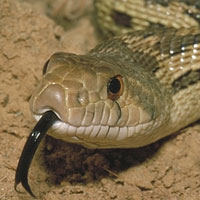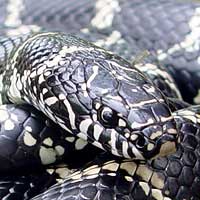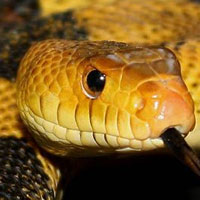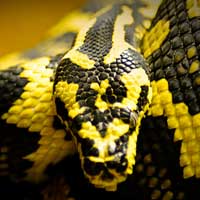Discover the Intriguing World of the Bushmaster Snake
The Bushmaster (Lachesis muta) belongs to the Viperidae snake family, known for its venomous species equipped with long, hinged fangs and a heat-sensing pit organ, making it a formidable predator in the tropical forests of Central and South America.
Scientific Name: Lachesis muta
Snake Family: Viperidae
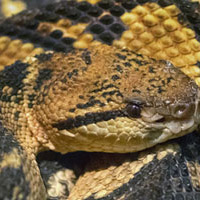
An Overview of the Bushmaster Snake
The Bushmaster (Lachesis muta) is the longest venomous snake in the Americas, known for its striking appearance and potent venom. Found in Central and South America, this snake is often elusive, inhabiting remote forested regions. Despite its intimidating reputation, the Bushmaster plays a critical ecological role as both a predator and a prey species in its environment.
Where Does the Bushmaster Call Home?
The Bushmaster thrives in tropical rainforests and lowland jungles, making its home in some of the most biodiverse regions of the world. Key habitat details include:
- Geographic Range: Found across Central and South America, including countries like Costa Rica, Brazil, and Peru.
- Preferred Environment: Dense forests with high humidity and abundant vegetation.
- Climate: Warm, tropical climates with average temperatures ranging from 25°C to 30°C.
| Habitat Feature | Details |
|---|---|
| Geographic Distribution | Central and South America |
| Preferred Terrain | Tropical rainforests |
| Climate | Warm and humid |
What Does the Bushmaster Eat?
The Bushmaster is a carnivorous predator that primarily hunts small mammals. Its diet includes:
- Primary Diet: Rodents, rabbits, and small marsupials.
- Occasional Prey: Birds and other reptiles.
- Hunting Style: Ambush predator, relying on camouflage and patience to strike unsuspecting prey.
This snake uses its heat-sensing pits to detect warm-blooded prey and delivers a venomous bite to immobilize it. The Bushmaster’s slow metabolism allows it to go weeks between meals, making it a highly efficient predator.
How Does the Bushmaster Behave?
The Bushmaster is a solitary and reclusive snake, known for avoiding human contact whenever possible. Key behavioral traits include:
- Activity Pattern: Primarily nocturnal, active during the night to hunt and explore.
- Social Behavior: Solitary, only coming together during mating season.
- Defense Mechanisms: Relies on camouflage and retreating when threatened but will deliver a defensive strike if cornered.
Despite its venomous nature, the Bushmaster is not inherently aggressive and prefers to avoid confrontation with humans or predators.
Health and Lifespan of the Bushmaster
The Bushmaster can live up to 20 years in captivity, with its lifespan in the wild typically ranging from 10 to 15 years. Factors affecting its health include:
- Common Health Issues: Parasitic infections and injuries from predators or prey.
- Lifespan: 10-15 years in the wild; up to 20 years in captivity.
- Predators: Birds of prey, large mammals, and humans pose threats, especially to juveniles.
Ensuring proper habitat and diet in captivity can significantly improve the Bushmaster’s health and longevity.
The Bushmaster’s Reproductive Cycle
Reproduction in Bushmasters occurs during the rainy season, with females laying eggs in secure, hidden locations. Key reproductive details include:
- Mating Season: Typically during the wet season, when food and resources are abundant.
- Clutch Size: 10-20 eggs per clutch.
- Incubation Period: Eggs hatch after approximately 90 days.
- Hatchling Behavior: Young snakes are independent from birth and possess venom to defend themselves.
By reproducing during optimal environmental conditions, the Bushmaster ensures the survival and growth of its offspring.
Handling and Safety Tips for the Bushmaster
Due to its size, strength, and venomous nature, handling the Bushmaster requires expertise and specialized equipment. Safety recommendations include:
- Always use snake hooks, tongs, and secure transport containers.
- Wear protective gear, such as gloves and boots, to minimize bite risk.
- Ensure the enclosure is escape-proof and mimics the snake’s natural habitat.
- Have antivenom available and ensure quick access to medical assistance.
Proper training and caution are essential when working with this formidable species to prevent accidents and ensure the snake’s well-being.
Disclaimer
The information provided in this article is for educational purposes only. SnakeEstate strongly advises against handling or interacting with venomous snakes, such as the Bushmaster, unless you are a trained and licensed professional. These snakes pose significant risks, and improper handling can result in serious injury or death. Always adhere to local regulations and prioritize safety when dealing with wildlife.
Other Snakes In This Species
 Asp Viper
Asp Viper Black Mamba
Black Mamba Boomslang
Boomslang Brazilian Coral Snake
Brazilian Coral Snake Bushmaster
Bushmaster Coastal Taipan
Coastal Taipan Common Death Adder
Common Death Adder Common European Adder
Common European Adder Copperhead
Copperhead Coral Snake
Coral Snake Cottonmouth
Cottonmouth Eastern Brown Snake
Eastern Brown Snake Eastern Diamondback Rattlesnake
Eastern Diamondback Rattlesnake Egyptian Cobra
Egyptian Cobra Fer-de-lance
Fer-de-lance Forest Cobra
Forest Cobra Indian Cobra
Indian Cobra Inland Taipan
Inland Taipan Jameson’s Mamba
Jameson’s Mamba King Cobra
King Cobra Lancehead
Lancehead Lataste’s Viper
Lataste’s Viper Malayan Krait
Malayan Krait Mojave Rattlesnake
Mojave Rattlesnake New Guinea Small-eyed Snake
New Guinea Small-eyed Snake Nose-horned Viper
Nose-horned Viper Puff Adder
Puff Adder Russell’s Viper
Russell’s Viper Saw-scaled Viper
Saw-scaled Viper Solomon Island Coral Snake
Solomon Island Coral Snake South American Rattlesnake
South American Rattlesnake Tiger Snake
Tiger Snake Western Diamondback Rattlesnake
Western Diamondback Rattlesnake



